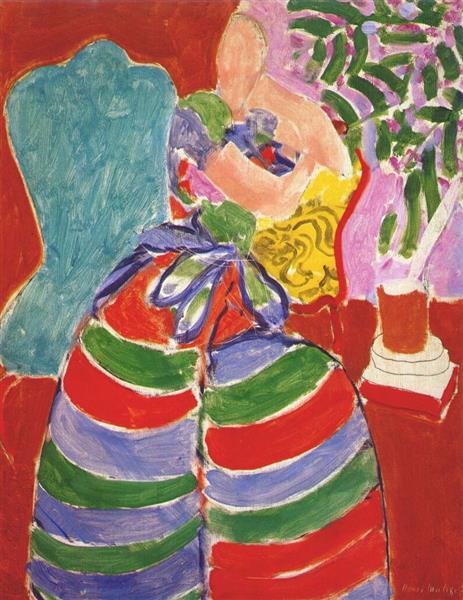Description
Henri Matisse, celebrated master of color and form, presents us in "The Striped Dress" (1938) with a work that encapsulates the vibrant essence and artistic sensitivity that characterize his prolific career. This 47 x 60 cm canvas stands out for its apparent simplicity, but upon deeper inspection reveals a fascinating complexity in composition and use of color that is emblematic of the artist's mature period.
In "The Striped Dress", Matisse offers us an intimate representation of a seated woman, wearing a striped dress that gives the work its name. The female figure occupies the central space, radiating serene contemplation. The choice of stripes is not fortuitous: the vertical lines of the dress not only guide the observer's gaze towards the main figure but also create a rhythmic tension and a sense of movement, contrasting with the stillness of the character. This is a common resource in Matisse's work, where the pattern and texture of the clothing significantly contribute to the compositional dynamism.
The color palette is direct but rich, predominantly featuring warm and cool tones in a harmony that only a master like Matisse could achieve. Blues and reds juxtapose, creating a vibrant interaction that animates the canvas's surface. Matisse's habit of exploring the emotional capacities of color finds a sublime manifestation in this work. The colors here not only suggest the reality of the dress but also evoke a palpable atmosphere of tranquility and reflection.
The setting in "The Striped Dress" is deliberately minimal. By opting for a simplified background, Matisse directs all attention to the central figure, avoiding any unnecessary distraction. This minimalist approach is indicative of his interest in the purity of form and the desire for the viewer to connect directly with the essence of the portrayed subject.
The woman's face, though delicately detailed, maintains a degree of abstraction. Her features are defined with a sure but simple stroke, allowing for an immediate emotional connection without overloading the image with minute details. This is another example of the effectiveness of Matisse's style, where less unquestionably becomes more.
Henri Matisse was a pioneer of Fauvism, a movement characterized by its bold and innovative use of color as the primary means of expressing emotion. Although "The Striped Dress" appears after his initial Fauvist phase, the influence of the movement persists in his color choices and the vibrant energy of his compositions.
This work fits perfectly within the Matissean tradition of combining compositional simplicity with formal exuberance. paintings earlier works like "The Romanian Blouse" (1940) and "Laurette in a Chaise Longue, with a Moorish Fan" (1922) also show an interest in the representation of women in interior settings with a marked interest in clothing and its relationship with the environment. The evolution from these works to "The Striped Dress" is a testament to Matisse's continuous development towards a greater distillation of forms and colors.
In conclusion, "The Striped Dress" is a work that, through its extraordinary simplicity and mastery in the use of color and form, captures the essence of Henri Matisse's artistic philosophy. It is a painting that invites contemplation, a gradual appreciation of the synergy between the human figure and the pictorial space, thus reaffirming Matisse's unwavering position as one of the giants of modern art.

